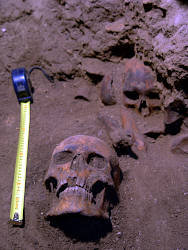Szelim-barlang
Szelim cave - Szelim-lyuk - Eperjes-barlang - Szemi-luki - Szemi-lyuka - Szelimluk barlang - Bánhidai-zsomboly - Szent Vit-barlang
Useful Information
| Location: |
Tatabánya.
M1 exit 56 Tatabánya, right on Highway 1, right on Panoráma út, up to Kő Hill, large parking lot. 200 m, 5 minutes, on a hiking trail marked with a red cave sign. (47.590278, 18.406944) |
| Open: |
No restrictions. [2022] |
| Fee: |
free. [2022] |
| Classification: |
 Karst Cave Karst Cave
|
| Light: | bring torch |
| Dimension: | L=45 m, H=14 m, A=289 m asl. |
| Guided tours: | self guided |
| Photography: | allowed |
| Accessibility: | no |
| Bibliography: |
István Gaál (1935):
A „Szelim-barlang eddigi ásatásának eredményeiről" (elhangzott a Magyar Barlangkutató Társulat szakülésén, MOTTL M. tolmácsolásában)
Barlangvilág 5, 27-29.
Bradák Balázs, Marko András (2006): A Szelim-barlang (Tatabánya) üledéksorának vizsgálata és fejlődéstörténetének vázlata (The study and historic reconstruction of the sedimentary sequence, in the Szelim Cave (Tatabánya)) Földtani Közlöny 136/2, 233-248. (2006), Budapest. pdf |
| Address: |
Gerecse Barlangkutató és Természetvédő Egyesülethez, Gál István Ltp. 405/a, 2800 Tatabánya.
E-mail: |
| As far as we know this information was accurate when it was published (see years in brackets), but may have changed since then. Please check rates and details directly with the companies in question if you need more recent info. |
|
History
| 1932 | excavated by Hubert Kessler. |
| 1934 | excavated by István Gaál. |
| 1982 | declared a Historic Monument. |
| 2013 | declared a protected natural national asset by the Hungarian Ministry of Interior. |
Description

Szelim-barlang (Szelim Cave) is also known under the name Bánhidai Nagy Barlang (Bánhidian Big Cave), Eperjes-barlang (trawberry cave), Szemi-luki, Szemi-lyuka, Szelimluk barlang, Bánhidai-zsomboly, and Szent Vit-barlang (St. Vit Cave). It’s definitely a cave with many names, and it is very well known and popular. Located in the Gerecse Mountains, there are numerous walking trails, a via ferrata and a lookout tower nearby. The cave is a single huge chamber, with two karstfenster in the ceiling, a big portal towards the valley, 10 m wide and 7.5 m high, through which it is accessible The cave has actually four entrances, one opens in the vertical cliff, and the smallest is only 70 cm high, so it is necessary to crawl. During the day it is well lit through the openings and no light is needed. The cave is especially photogenic when the sun shines in. The cave visit is very easy, and it is easily reached in a 5 minutes walk from the Turul Monument.
The first excavation in the cave by Hubert Kessler in 1932 revealed Pleistocene and Holocene vertebrate remains, pottery and three shards which were thought to be prehistoric. The result was never published, obviously there were no spectacular results, but at least it became clear that further excavations would be rewarding. His results encouraged István Gaál to start regular excavations, two years later, financed by the Natural History Research Council. He moved nearly 2000 m³ of cave sediment almost emptying the cave. At some places there were 12 m of sediment. He separated five culture layers and excavated the remains of hearths, stoves, carvings, animal bones and humans from the era of Turkish invasions. And he is responsible for the current look, as he removed all the sediments which originally filled most of the cave. In the small remains, a more recent excavation discovered artefacts and stone tools from the Upper Paleolithic. The oldest remains from the cave were dated 200,000 BC, from the Mousterian.
During the Turkish Wars the inhabitants of seven neighboring villages, Környe, Bánhida, Galla, Szőllős, Baj, Agostyán, and Tardos, were hiding in the cave from Szelim sultan’s troops who devastated Transdanubia.
Unfortunately, the Turks found them, when they noticed a woman who went down to the creek, to bring drinking water to her thirsty child, and followed her to the cave.
The people had blocked the cave entrance, so the Turks could not get them out.
Finally, they killed them with smoke, by throwing burning straw through the opening in the ceiling.
Local legend.
This legend was a result of the massive fear of the Turks, who actually invaded several times and even besieged Vienna. And the big number of human bones which could be seen on the floor of the cave made the story quite likely. However, according to the archaeological excavations the bones are from the time of the Tartar invasion. The cave is not only a Historic Monument, it is under special protection, one of only six caves in Hungary. It is managed by the non-profit organization Gerecse Barlangkutató és Természetvédő Egyesülethez (Gerecse Cave Research and Nature Conservation Association).
Lately the cave was filming location for the Netflix series The Witcher. It is the dragon’s lair in season 1, episode 6 "Rare Species".
 Search DuckDuckGo for "Szelim-barlang"
Search DuckDuckGo for "Szelim-barlang" Google Earth Placemark
Google Earth Placemark Szelim cave - Wikipedia (visited: 06-JUL-2020)
Szelim cave - Wikipedia (visited: 06-JUL-2020) Szelim barlang Kisokos 2022 - Tudnivalók, bejárat, parkolás ...
Szelim barlang Kisokos 2022 - Tudnivalók, bejárat, parkolás ...  (visited: 13-APR-2022)
(visited: 13-APR-2022) Index
Index Topics
Topics Hierarchical
Hierarchical Countries
Countries Maps
Maps